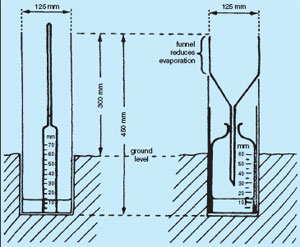Precipitation
Content
The term precipitation covers all the ways in which water reaches the ground as rain, snow and hail. It is usually measured with a rain gauge (see Figure 2.13). Simple rain gauges are based on straight-sided cans set in the ground with a dipstick used to determine the depth of water collected. Accurate readings to provide daily totals are achieved with a design that maximizes collection, but minimizes evaporation losses by intercepting the precipitation water in a funnel. This leads to a tapered measuring glass calibrated to 0.1 mm. These gauges are positioned away from anything that affects the local airflow e.g. buildings, trees and shrubs. They are set in the ground but with the rim above it to prevent water running in from the surroundings. Recording rain gauges are available which also give more details of the pattern of rainfall within twenty-four hour periods. The 'tipping bucket’ type has two open containers on a see-saw mechanism so arranged that as one bucket is filled, it tips and this is recorded on a continuous chart; meanwhile the other bucket is moved into position to continue collection. |





